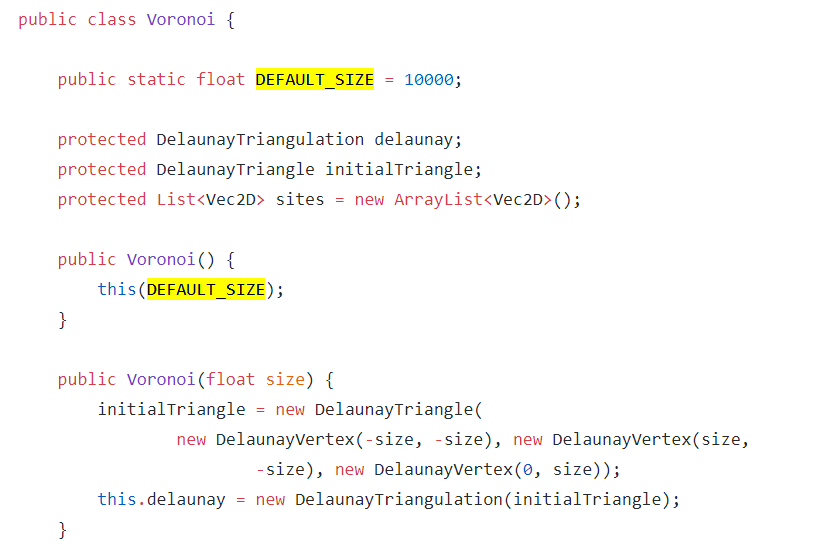I am using the Toxiclibs voronoi mesh to generate a set of non-overlapping lines in a circle, and have based my sketch on the example code I found at https://forum.processing.org/one/topic/toxiclib-voronoi-example-sketch.html
For smaller image sizes (3000x3000 and smaller) the code below is working as intended, but on larger images (5000x5000 and larger) I sometimes get an exception when voronoi.addPoint() is called:
Warning: Checking all triangles for DelaunayVertex(4802.423828125,1680.7874755859375)
Warning: No triangle holds DelaunayVertex(4802.423828125,1680.7874755859375)
IllegalArgumentException: No containing triangle
IllegalArgumentException: No containing triangle
IllegalArgumentException: No containing triangle
In the saved image I see all the points, but the mesh between the points is not present in the lower right part of the image. As the image size increases, the size of the region without mesh also increases (10% size image, let me know if you want to see the full size image):

My goal is to have a 30000 x 30000 image, with the lines evenly distributed across the circle, so any help would be greatly appreciated.
The full sketch is:
import toxi.geom.*;
import toxi.geom.mesh2d.*;
import toxi.util.*;
import toxi.util.datatypes.*;
import toxi.processing.*;
// ranges for x/y positions of points
FloatRange xpos, ypos;
// helper class for rendering
ToxiclibsSupport gfx;
// empty voronoi mesh container
Voronoi voronoi = new Voronoi();
// switches
boolean doShowPoints = true;
boolean doShowHelp = false;
boolean doSave = true;
int seed=12345;
int imageDim = 5000;
int numPoints = 0;
void settings(){
size(imageDim, imageDim);
}
void setup() {
randomSeed(seed);
smooth();
xpos=new FloatRange(0, width);
ypos=new FloatRange(0, height);
gfx = new ToxiclibsSupport(this);
textFont(createFont("SansSerif", 10));
addRandomPoints(1000);
}
void draw() {
//White background
background(255);
//Background circle
fill (170, 170, 170);
ellipse(width*0.5, height*0.5,width, height);
// draw all voronoi polygons, clip them if needed...
stroke(0);
noFill();
for(Polygon2D tri : voronoi.getRegions()) {
java.util.List<Vec2D> vert = tri.vertices;
for(int i=0; i<vert.size(); i++){
Vec2D p1=vert.get(i);
Vec2D p2=vert.get((i+1) % vert.size());
Vec2D start=p1.interpolateTo(p2,0.1);
Vec2D end=p1.interpolateTo(p2,0.9);
if(onCircle(start) && onCircle(end)){
gfx.line(start,end);
}
}
}
// draw original points added to voronoi
if (doShowPoints) {
fill(255, 0, 255);
noStroke();
for (Vec2D c : voronoi.getSites()) {
ellipse(c.x, c.y, 5, 5);
}
}
if (doSave) {
saveFrame("Points" + numPoints + "_" + DateUtils.timeStamp() + ".tif");
doSave = false;
}
}
void keyPressed() {
switch(key) {
case ' ':
doSave = true;
break;
case 'x':
voronoi = new Voronoi();
break;
case 'p':
doShowPoints = !doShowPoints;
break;
case 'h':
doShowHelp=!doShowHelp;
break;
case 'r':
addRandomPoints(100);
break;
}
}
void addRandomPoints(int count){
Vec2D p = new Vec2D(0,0);
for (int i = 0; i < count; i++) {
p.set(xpos.pickRandom(), ypos.pickRandom());
try {
voronoi.addPoint(p);
}
catch(Exception e) {
numPoints--;
}
}
numPoints += count;
}
boolean onCircle(Vec2D a) {
Vec2D c = new Vec2D(width/2, height/2);
float maxRadPx = width/2;
return (a.distanceTo(c) <= maxRadPx);
}

